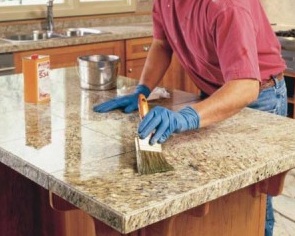The trend in many homes the past few years has been stone counter tops in kitchens, bathrooms and other entertainment areas. Many people have also opted to put in stone tiles as flooring in certain rooms. These stones vary from granite, marble, travertine, and more. Some stone surfaces are porous and can absorb water and moisture. It is important to understand each stone surface you have, and find the appropriate product to reseal stone surfaces. Many of the porous stones will start to discolor over time if they absorb too much water and moisture, and ruin your overall aesthetic look of the tile and the room.
How to reseal stone surfaces
When you are ready to reseal stone surfaces in your home, the first thing to do is to understand what stone type you have and the manufacturer’s instructions on how to seal them. Understanding the stone you have and which product is best suited to your stone will be important because some solutions can damage your stone. Some stone surfaces like granite are naturally harder than other stones, while stones like marble are traditionally more porous.
The basics of resealing your stone surface is to purchase the appropriate stone sealer based on the type of stone you have and how that surface is being used. Make sure the surface is clean and dry. You will typically reseal stone surfaces by applying the stone sealer with a rag or soft brush following the instructions of the product you purchased.
You will also need a dry towel to wipe up anyexcess sealer as you typically do not want excess sealer to sit on the surface because it could bubble and create an uneven finish. Some surfaces may require multiple coats which usually means there is a drying time between coats. Be sure to read the instructions of the penetrating sealer you purchase.
To learn more about your home maintenance tips, visit HomeZada’s library.


